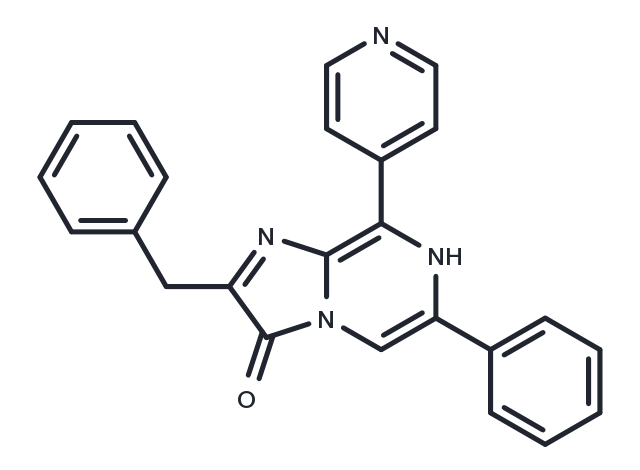Powder: -20°C for 3 years | In solvent: -80°C for 1 year


8pyDTZ is a pyridyl diphenylterazine (DTZ) analog and an ATP-independent pyridyl substrate of LumiLuc luciferase. 8pyDTZ exhibits spectrally shifted emission and improved water solubility. It can be used for in vivo luminescence imaging.

| Pack Size | Availability | Price/USD | Quantity |
|---|---|---|---|
| 25 mg | 6-8 weeks | $ 1,330.00 | |
| 50 mg | 6-8 weeks | $ 1,740.00 | |
| 100 mg | 6-8 weeks | $ 2,500.00 |
| Description | 8pyDTZ is a pyridyl diphenylterazine (DTZ) analog and an ATP-independent pyridyl substrate of LumiLuc luciferase. 8pyDTZ exhibits spectrally shifted emission and improved water solubility. It can be used for in vivo luminescence imaging. |
| In vitro | 8pyDTZ, with a solubility of 1711 μM, significantly increases water solubility by 13-fold over DTZ (131 μM). This compound not only shows a capability for red-shifted chemiluminescence and bioluminescence emission compared to DTZ but also produces the most red-shifted emission, allowing for improved tissue penetration. In evaluations using human embryonic kidney 293T cells expressing luciferase (HEK 293T cells), the LumiLuc-8pyDTZ combination yields approximately 3-5 times more bioluminescence than the teLuc-8pyDTZ pair. Additionally, when comparing far-red emission intensities with a 600-700 nm bandpass filter, LumiLuc-8pyDTZ consistently achieves 1.6-3.9 times higher photon flux than teLuc-DTZ across substrate concentrations ranging from 6.25 to 100 μM, without affecting ATP levels in LumiLuc-expressing cells treated with 8pyDTZ. |
| In vivo | The LumiLuc-8pyDTZ pair was evaluated alongside various standard reporters within a tumor xenograft mouse model, exhibiting high sensitivity and eliminating the need for organic cosolvents for in vivo administration. Additionally, LumiScarlet-8pyDTZ demonstrated equivalence to Akaluc-AkaLumine, the most luminous ATP-dependent luciferase-luciferin pair, in detecting cells within deep mouse tissues. |
| Molecular Weight | 378.43 |
| Formula | C24H18N4O |
| CAS No. | 2351898-91-2 |
Powder: -20°C for 3 years | In solvent: -80°C for 1 year
EtOH+HCl: 2 mg/mL (5.28 mM), when pH is adjusted to 2. Sonication is recommended. (DMSO inactivates the activity of 8pyDTZ.)
You can also refer to dose conversion for different animals. More
bottom
Please see Inhibitor Handling Instructions for more frequently ask questions. Topics include: how to prepare stock solutions, how to store products, and cautions on cell-based assays & animal experiments, etc.
8pyDTZ 2351898-91-2 Others inhibitor inhibit
